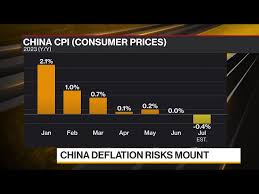The GDP deflator, the widest measure of prices in the economy, has fallen for the last three quarters, the longest streak since 1999.
As China heads into the lunar Year of the Dragon, traditionally seen as one of the most auspicious creatures on the zodiac, the country’s leaders are struggling to restore confidence at home and abroad.

The economy is besieged by deflation, a persistent housing market slump and a stock selloff. And Beijing’s piecemeal stimulus policies—such as lowering bank reserve requirements to encourage more lending and issuing more government bonds to fund construction projects—don’t seem to be improving sentiment.
A key issue is the government’s focus on promoting what President Xi Jinping calls “high-quality development,” an umbrella term for a variety of policy goals, from boosting China’s high-tech capabilities to combating social inequality. That’s a more complex ambition than officials’ earlier single-minded fixation on achieving high levels of economic expansion. “The biggest challenge is Beijing’s inattention to deteriorating growth, which exacerbates all the structural and secular problems China faces,” says Houze Song, an economist at the Paulson Institute, a think tank focused on US-China relations. “And the solution is to assign a bigger weight to growth in government policy.”
Here are five charts that zero in on China’s pain points in 2024.
- Deflation Now Tops List of Worries The term “deflation” describes a situation in which prices for goods and services fall across a large swath of the economy.
Adjusted for inflation, China’s gross domestic product expanded 5.2% in 2023. But in nominal terms the world’s No. 2 economy grew 4.6%, the slowest pace in almost four decades, not counting the years when pandemic restrictions were in place. “It’s nominal growth, not real growth, that matters for corporates, households and investors,” says Larry Hu, the top China economist at Macquarie Group Ltd.
The GDP deflator, the widest measure of prices in the economy, has fallen for the last three quarters, the longest streak since 1999. Manufacturing is leading the price drops—a side effect of Beijing’s approach to economic stimulus. Officials are channeling credit to manufacturers to boost output. But with growth in consumer spending on goods weak at home and demand for Chinese exports also flagging overseas, businesses are left with little choice but to mark down their products.
- While Old Problems Persist
China’s economy grew faster than the US’s last year, but relative to expectations at the start of 2023, the former underperformed, while the latter consistently beat estimates.
Despite Beijing’s efforts to deter real estate speculation, construction still represents a huge chunk of the economy, driving demand for goods and services worth around 20% of GDP, according to Bloomberg Economics. Related sectors such as household furnishings and cement are also being dragged down. And there’s a spillover effect to other areas, as falling home prices make many households reluctant to spend on everything from electronics to luxury goods.
- Need More, Better Stimulus
Chinese government advisers’ calls for more stimulus reached a fever pitch last summer, and Beijing responded with an unusual midyear dose of deficit spending. While the timing signaled a welcome flexibility, the scale of the effort, at 1 trillion yuan ($13.9 billion), paled compared with past interventions. Government officials channeled funds into construction, a tried-but-less-true method of spurring the economy, ignoring recommendations that directing assistance to households might yield better results.
- Feeling Low
Stubbornly low confidence among households and businesses is blunting the impact of stimulus. That may be a hangover from the past few years, which along with the housing slump have been marked by unpredictable pandemic restrictions, sudden crackdowns on sectors including education and tech, and rising US-China tensions.
One sign Chinese families are feeling less secure: Rather than investing in housing or stocks, they’re socking money away in savings accounts at banks. Companies are being showered with credit, but outside of growth sectors such as electric vehicles and cleantech, business owners appear to be reluctant to expand amid weak demand and falling prices.
- Finding the Floor
Worries about China’s future are reflected in prices of stocks traded at exchanges on the mainland and in Hong Kong. A yearlong rout has wiped away about $6 trillion in market value, from a peak in 2021.
Although the stock market isn’t a reliable tracker of China’s economy over the long term, in the medium term it’s sensitive to trends in nominal growth because they affect profits. So Beijing’s efforts to boost valuations by tweaking market rules, such as restricting short selling, and possibly using government funds to buy stocks at scale—an idea that was floated last month—are unlikely to produce a lasting upswing.